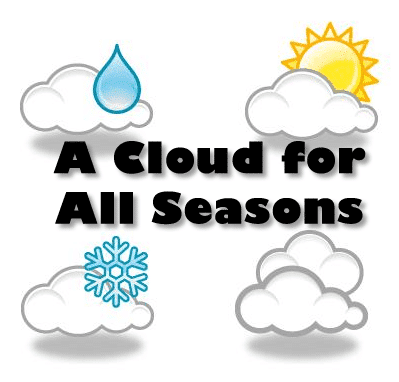Cloud computing can be very confusing. It can be abstractly discussed but also detailed to intricate levels. A few years ago, part of the reason why people weren’t adopting cloud computing was because they simply didn’t understand it and what it could do for them. And, a few years ago, the technology and services were relatively new and not as built-out and established as they are now.
In my previous posts of this series, I talked about what I thought would come in 2012 for cloud computing, I debunked a few common misstatements about the cloud and, I listed out some ways to make cloud computing work better for people. With this article, I’m going to break down some of the different types of clouds and explain how they might be used.
Because the cloud is relatively new to many businesses and individuals, I typically describe and explain it more as a generalist than a technologist. If you get into the weeds too quickly, you can frequently lose your audience. That is not my goal in this article. If you want to get into the geek speak about which hypervisor you should look for (hint: it doesn’t really matter), what type of I/O performance should you be achieving or how to configure a Cassandra DB cluster that spans multiple data centers with real-time replication, you aren’t going to find that here. I like to keep things moderately simple so that more people can understand and hopefully gain insights into why cloud computing might be the right choice for them.
This list is not complete, but should provide you with some of the most prevalent clouds out there. You, of course, have the daunting task of trying to decide which one works best for your business or personal needs.
Public Cloud
This type of cloud is publicly available to businesses and consumers. Typically, these have multiple data center locations and offer a variety of services. My earlier articles talk about the layers within public cloud: Software, Platform & Infrastructure, so I won’t go into the details of those. An important thing to note is that public clouds are multi-tenant, meaning that whatever virtualized instance you are running, the server exists on shared space with other customers. Because of the way hypervisors (Xen, KVM, VMware & others) are designed, you typically will not notice performance degradation from “noisy neighbors” the way you would in a Virtual Private Server or Shared Hosting environment. But, it is an important consideration to think about given that it is indeed using shared resources. But by sharing resources (bandwidth, CPU, RAM, Storage) you also get the benefit of economies of scale. The hypervisor and the management layer co-exist to ensure that you DON’T have any issues with shared resources. Ok, I got a bit geeky there, sorry. The bottom line is, Public Clouds are a fantastic choice for businesses looking to stop purchasing and managing physical hardware and data centers, and transform this capital expenditure to an operating expenditure. Essentially, you lease compute and/or storage and consume bandwidth, but all without purchasing anything physical.
Private Cloud
When people talk about private clouds, they typically have a need to keep their entire infrastructure and contents therein, private. This could be due to their environment containing sensitive data or having to have enhanced security of their architecture. Simply put, think of a public cloud but in a private environment – one that is dedicated to a single entity or corporation. They are typically pretty expensive, but you are paying for this “privilege” in order to gain privacy or enhance security. Private clouds can come in a variety of flavors, hosted (managed by a provider) and in-house (managed by a customer in their own data center). Obviously, the in-house one will be more expensive, typically because there is a capital outlay to set up the environment. With any type of cloud, large, high-end servers are used with virtualization technology in order to carve our smaller virtual servers, thus the need to purchase (or lease) these higher end servers for private clouds. With a hosted private cloud, there is typically only a management fee associated with the costs and that gets you a private cloud that is maintained by a provider in their own data center or perhaps a rack or cage at a customer’s data center or hosting facility. Regardless, the hosted private cloud is isolated to that specific customer.
Hybrid Cloud
Hybrid clouds are typically two or more clouds that are linked together via a dedicated private connection or VPN (Virtual Private Network). Hybrid clouds could be a linkage between public clouds, a private and a public cloud, or even a physical data center with a cloud. Hybrid clouds can be used to extend a company’s infrastructure for redundancy or disaster recovery, meaning that if there is an issue with one cloud, traffic could be routed to a different cloud. Sometimes hybrid clouds are used for bursting, meaning the primary traffic is handled by one pre-defined cloud and then overflow could be routed to a secondary cloud and scaled back. This is somewhat similar to what can be configured within a single cloud environment, where virtualized servers can be scaled out when demand requires it and scaled back when the demand subsides. The difficulty of setting up and delivering a hybrid cloud environment is that frequently there are differences in architectures of different cloud vendors, especially if they have their own proprietary infrastructure protocols. There are service companies available that provide management consoles or libraries to unify the management of different vendors’ infrastructure services. Hybrid clouds should not be confused with Hybrid Hosting, another practical implementation of cloud computing combined with dedicated, managed physical server environments.
Virtual Private Cloud
You can create a “private cloud” environment within a public cloud and these are known as virtual private clouds. Obviously, these are not true private clouds because they reside within multi-tenant environments (e.g., public clouds). There is a bit of a gray area, in my mind, between a hybrid cloud and a virtual private cloud. Regardless, if the connection between a company’s legacy computing environment and the public cloud is completely private and secured (e.g., using a VPN), this would be considered a virtual private cloud. Typically, the public cloud part of the equation is used to extend a customer’s existing infrastructure. With a virtual private cloud, external access to the public cloud is cut off and all connections travel via the VPN from the customer, or within a VLAN or private network between servers within the public cloud environment.
Cloud Washing
I had to throw this term into the mix because it is an important one to know and remember when you are shopping for cloud solutions. When cloud computing first started out, there were just a few players making any kind of money and establishing a foothold. But as adoption grew, so did the desire to join the ranks of being a cloud provider. The problem was, many of these companies who did “join”, really weren’t providing true cloud computing solutions. They were simply slapping the label of “cloud” on their existing offerings and saying that they were selling “cloud.” Remember, for something to be “cloud”, you have to be able to deploy infrastructure yourself, pay just for what you consume and be able to scale your environments via a management console or programmatically quickly and easily. Also, most clouds are multi-tenant and utilize some sort of virtualization in their compute provisioning and leasing. For example, you might find some Virtual Private Server (VPS) or shared hosting companies say they provide “cloud” because they carve out space on two machines and link them together. That’s NOT cloud. You have to control it and scale it. Just be sure that whichever vendor you choose passes the cloud computing litmus test and has the cloud characteristics that I have (repeatedly) mentioned.
A Cloud For All Seasons
Ok, I lied a bit. I guess I had to geek out a bit to really get into it. The cloud types that I mentioned above are just a few of the many that have emerged. These types are becoming mainstream and being utilized by corporations, developers and IT professionals. The most important thing you can do when shopping and evaluating cloud computing vendors is to first understand what your OWN needs are. If you don’t understand what your company is trying to accomplish from an IT perspective, or even more generally, from a business standpoint, you are not going to have a clue as to which type of cloud to use or build. But you are taking the right first step, that of RESEARCH, by reading this article. And be sure to review my ways to make cloud computing work for you article. Also, talk to the vendors out there. Explain what you want to do. Give them examples. Attend industry trade shows. Basically, become as knowledgeable as you can about your needs and what’s available.
Cloud computing sounds complicated and it can be depending on your requirements and the type of cloud you choose. But it is also a new way to think about computing. It’s here to stay so use it to your advantage and get ahead of the curve.
HTD says: Hopefully your understanding of cloud computing is a bit less “cloudy” in your mind and you can now actually get into the cloud!









